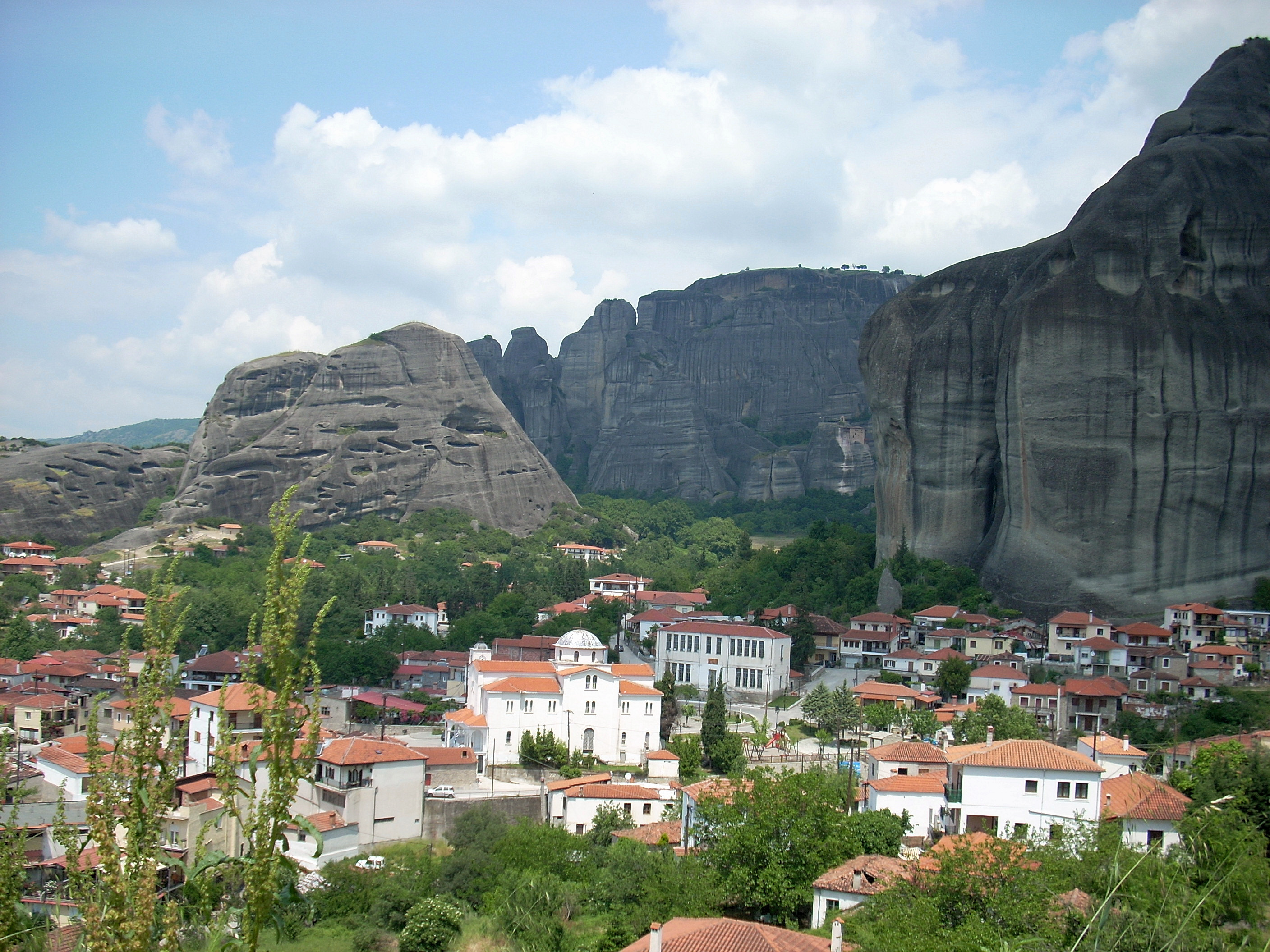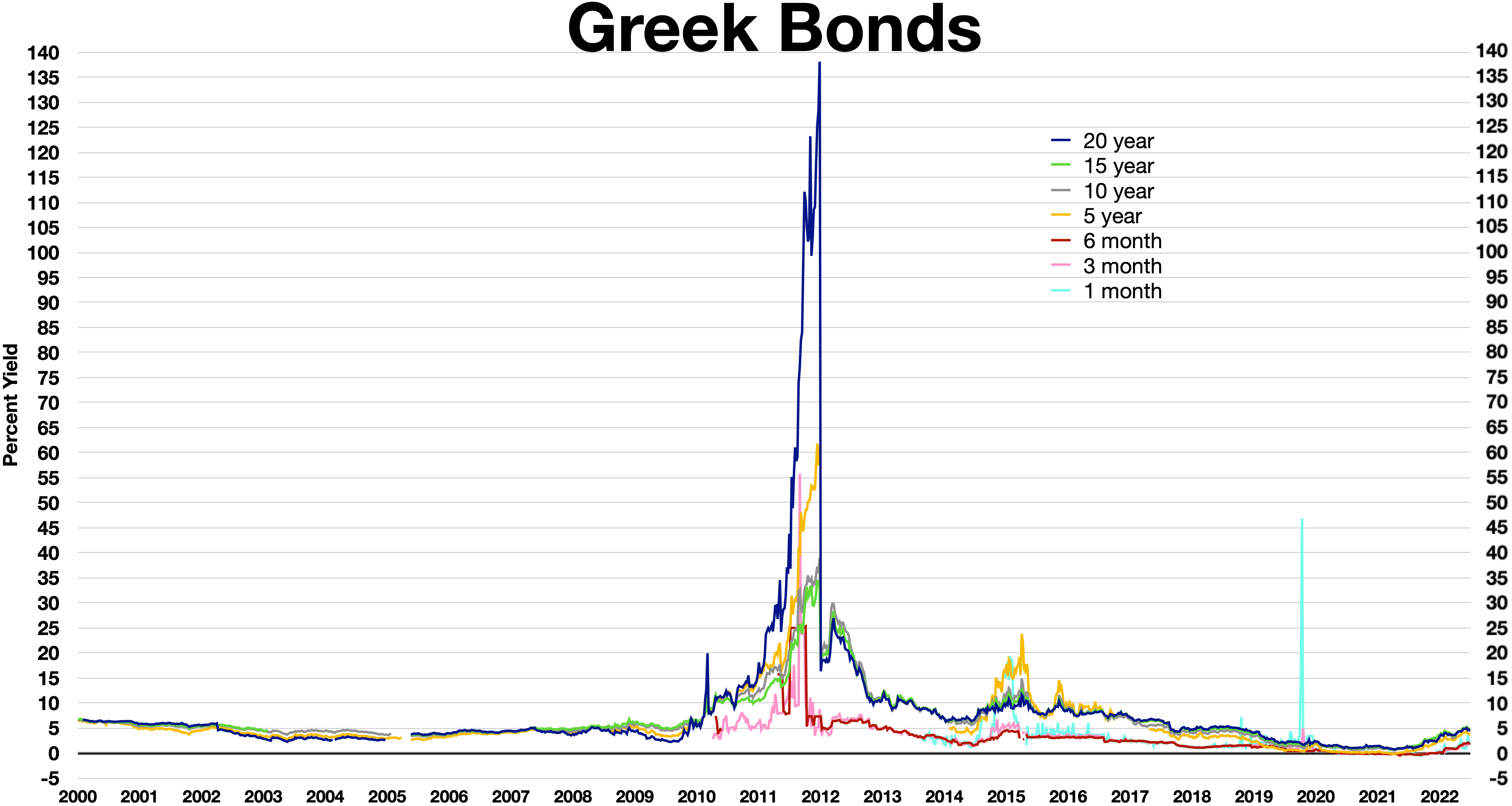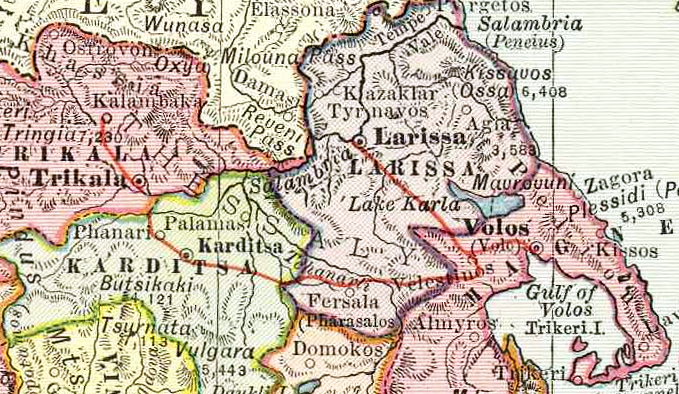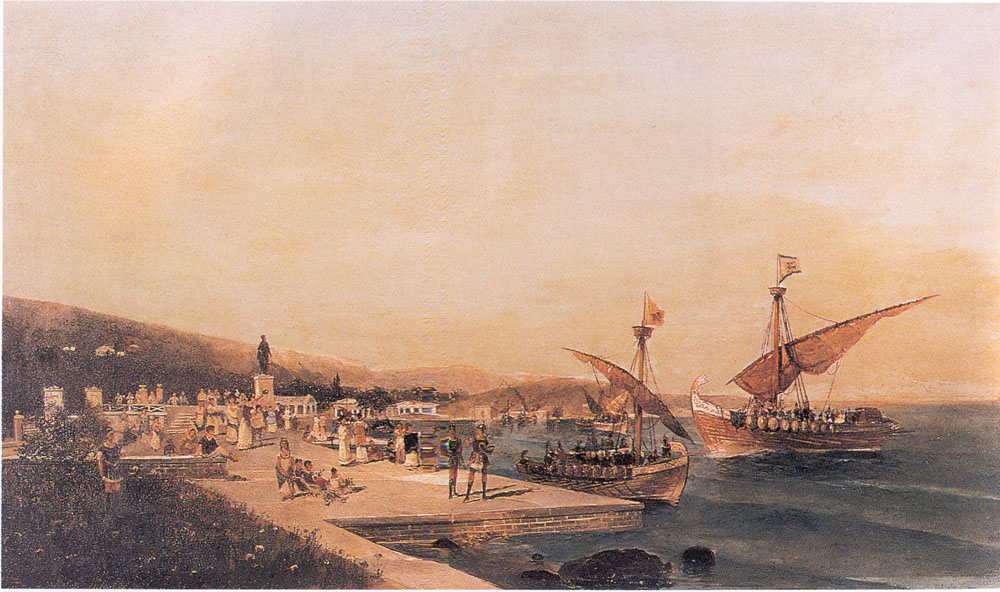|
Palaiofarsalos Railway Station
Palaiofarsalos railway station ( el, Σιδηροδρομικός Σταθμός Παλαιοφαρσάλου, Sidirodromikós Stathmós Palaiofarsálou) is a railway station near Farsala in Larissa regional unit, Greece. It is located in the village Stavros, west of Farsala. It is situated at the junction of the main Piraeus–Platy railway and the branch line to Trikala and Kalambaka. It is served by intercity trains between Athens and Thessaloniki and by local trains to Kalambaka.TrainOSE 2013 timetable History The Palaiofarsalos station opened in 1908 as Demerli at the meeting point between the metric line of the Thessaly Railways (S.Th.) and the standard line of the Piraeus-Demerli-Sinoron Railway (S.P.D.S.) or “Larissaykos”. After the |
Stavros, Larissa
Stavros ( el, Σταυρός, ''Stavrós''; before 1927: Demerli (Δεμερλή, ''Demerli'')) is a village in the south of the Larissa regional unit, Greece. It is part of the municipal unit of Enippeas. In 2011 its population was 602. Stavros is located west of Farsala, east of Karditsa and southwest of Larissa Larissa (; el, Λάρισα, , ) is the capital and largest city of the Thessaly region in Greece. It is the fifth-most populous city in Greece with a population of 144,651 according to the 2011 census. It is also capital of the Larissa regiona .... The important railway junction Palaiofarsalos is situated in Stavros. References {{Farsala div Populated places in Larissa (regional unit) ... [...More Info...] [...Related Items...] OR: [Wikipedia] [Google] [Baidu] |
Kalambaka
Kalabaka ( el, Καλαμπάκα, ''Kalabáka'', alternative transliterations are ''Kalambaka'' and ''Kalampaka'') is a town and seat of the municipality of Meteora in the Trikala regional unit, part of Thessaly in Greece. The population was 12,000 at the 2011 census, of which 8,330 in the town proper. The Meteora monasteries are located near the town. Kalabaka is the northwestern terminal of the old Thessaly Railways, now part of OSE. History A Greek inscription on the wall of one of the town's oldest churches (Saint John the Baptist) testifies to the existence of an ancient Greek settlement under the name Aiginion. In the 10th century AD, it was known as Stagoi (Σταγοί), a Byzantine fortress and bishopric (the name is still in use for the town by the Greek Orthodox Church). Of its medieval monuments, only the cathedral, the Church of the Dormition, survives. It was a late 11th- or early 12th-century building, built on the remains of an earlier, late antique chu ... [...More Info...] [...Related Items...] OR: [Wikipedia] [Google] [Baidu] |
TrainOSE
Hellenic Train S.A., formerly TrainOSE S.A. ( el, ΤραινΟΣΕ Α.Ε., pronounced ''trenosé'') is a private railway company in Greece which currently operates passenger and freight trains on OSE lines. TrainOSE was acquired in September 2017 by the Italian national railway company, Ferrovie dello Stato Italiane. The company was a subsidiary of the Hellenic Railways Organisation (OSE) until 2008, when it became an independent state-owned company until its privatisation in 2017. Hellenic Train employs train crews, operators and manages the most of rail services throughout the Greek railway network, leasing rolling stock owned by GAIOSE except for ETR 470 trains. In 2022 the company rebranded as Hellenic Train. History The company was a subsidiary of the Hellenic Railways Organisation (OSE) and has been since 2005. Before 2005 it had been an in-house service of OSE. In 2008 the company became an independent state-owned company. In 2017 it became a wholly-owned subsidiary of ... [...More Info...] [...Related Items...] OR: [Wikipedia] [Google] [Baidu] |
Greek Government-debt Crisis
Greece faced a sovereign debt crisis in the aftermath of the financial crisis of 2007–2008. Widely known in the country as The Crisis ( Greek: Η Κρίση), it reached the populace as a series of sudden reforms and austerity measures that led to impoverishment and loss of income and property, as well as a small-scale humanitarian crisis. In all, the Greek economy suffered the longest recession of any advanced mixed economy to date. As a result, the Greek political system has been upended, social exclusion increased, and hundreds of thousands of well-educated Greeks have left the country. The Greek crisis started in late 2009, triggered by the turmoil of the world-wide Great Recession, structural weaknesses in the Greek economy, and lack of monetary policy flexibility as a member of the Eurozone. The crisis included revelations that previous data on government debt levels and deficits had been underreported by the Greek government: the official forecast for the 2009 budg ... [...More Info...] [...Related Items...] OR: [Wikipedia] [Google] [Baidu] |
Thessaloniki
Thessaloniki (; el, Θεσσαλονίκη, , also known as Thessalonica (), Saloniki, or Salonica (), is the second-largest city in Greece, with over one million inhabitants in its Thessaloniki metropolitan area, metropolitan area, and the capital city, capital of the geographic regions of Greece, geographic region of Macedonia (Greece), Macedonia, the administrative regions of Greece, administrative region of Central Macedonia and the Decentralized Administration of Macedonia and Thrace. It is also known in Greek language, Greek as (), literally "the co-capital", a reference to its historical status as the () or "co-reigning" city of the Byzantine Empire alongside Constantinople. Thessaloniki is located on the Thermaic Gulf, at the northwest corner of the Aegean Sea. It is bounded on the west by the delta of the Vardar, Axios. The Thessaloniki (municipality), municipality of Thessaloniki, the historical center, had a population of 317,778 in 2021, while the Thessaloniki metro ... [...More Info...] [...Related Items...] OR: [Wikipedia] [Google] [Baidu] |
Athens
Athens ( ; el, Αθήνα, Athína ; grc, Ἀθῆναι, Athênai (pl.) ) is both the capital and largest city of Greece. With a population close to four million, it is also the seventh largest city in the European Union. Athens dominates and is the capital of the Attica region and is one of the world's oldest cities, with its recorded history spanning over 3,400 years and its earliest human presence beginning somewhere between the 11th and 7th millennia BC. Classical Athens was a powerful city-state. It was a centre for the arts, learning and philosophy, and the home of Plato's Academy and Aristotle's Lyceum. It is widely referred to as the cradle of Western civilization and the birthplace of democracy, largely because of its cultural and political influence on the European continent—particularly Ancient Rome. In modern times, Athens is a large cosmopolitan metropolis and central to economic, financial, industrial, maritime, political and cultural life in Gre ... [...More Info...] [...Related Items...] OR: [Wikipedia] [Google] [Baidu] |
Sofades
Sofades ( el, Σοφάδες) is a town and municipality in Thessaly, central Greece belonging to the regional unit of Karditsa. Its 2011 census population was 6,056 people and 18,864 for the municipality, including a large Romani community. Its elevation is around 120 m above sea level, and the economy is mainly agricultural (cotton, corn). It is the only municipality that has one municipal district with settlements. Sofades is located south of Palamas, southwest of Larissa, the capital of Thessaly, northwest of Lamia and southeast of Karditsa and Trikala. Sofades is on GR-30 (Karditsa - Domokos - Volos) as well as the road between Mataragka and Palamas. It is on the OSE railway line linking Kalambaka and the main line and has a station. The native Greek inhabitants of the region are commonly known as Karagounides (Καραγκούνηδες). History The modern town is very close to the site of the ancient city of Kierion ( el, Κιέριον) or Cierium, one of the most imp ... [...More Info...] [...Related Items...] OR: [Wikipedia] [Google] [Baidu] |
Modernist Architecture
Modern architecture, or modernist architecture, was an architectural movement or architectural style based upon new and innovative technologies of construction, particularly the use of glass, steel, and reinforced concrete; the idea that form should follow function ( functionalism); an embrace of minimalism; and a rejection of ornament. It emerged in the first half of the 20th century and became dominant after World War II until the 1980s, when it was gradually replaced as the principal style for institutional and corporate buildings by postmodern architecture. Origins File:Crystal Palace.PNG, The Crystal Palace (1851) was one of the first buildings to have cast plate glass windows supported by a cast-iron frame File:Maison François Coignet 2.jpg, The first house built of reinforced concrete, designed by François Coignet (1853) in Saint-Denis near Paris File:Home Insurance Building.JPG, The Home Insurance Building in Chicago, by William Le Baron Jenney (1884) File:Constr ... [...More Info...] [...Related Items...] OR: [Wikipedia] [Google] [Baidu] |
Hellenic State Railways
Hellenic State Railways or SEK ( el, Σιδηρόδρομοι Ελληνικού Κράτους, ''Sidirodromi Ellinikou Kratous''; Σ.Ε.Κ.) was a Greek public sector entity (legal person of public law, el, Ν.Π.Δ.Δ.) which was established in 1920 and operated most Greek railway lines until 1970. History The Hellenic State Railways took over the standard gauge railway line from Piraeus to Papapouli at the pre-1912 borders, the extension from Papapouli to Platy and most of the former Ottoman railway lines that were within the Greek borders after 1919. These lines were: * ''Piraeus, Demerli & Frontiers Railway'' ( el, Σιδηρόδρομος Πειραιώς-Δεμερλή-Συνόρων), also known as * Part of the former ''Thessaloniki & Monastir Railway'' (french: Chemin de fer de Salonique à Monastir or SM) * Part of or CO, between Thessaloniki and Idomeni. The line from Alexandroupolis to Ormenio was transferred to the French-Hellenic Railway Company (, CFFH) of Ev ... [...More Info...] [...Related Items...] OR: [Wikipedia] [Google] [Baidu] |
Thessaly Railways
Thessaly Railways ( el, Σιδηρόδρομοι Θεσσαλίας) was a railway company in Greece, which owned and operated the metre gauge railway network of Thessaly and Pelion railway from 1884 to 1955, when the company was absorbed by the Hellenic State Railways. Today the term usually refers to the section of mainline between Domokos and Rapsani and its two branches, the West Thessaly branch to Kalambaka and the Volos branch. Network and stations The network of Thessaly Railways consisted of the following lines: * Volos—Velestinon. The line extended from Volos station to the city centre along Dimitriados Street. * Velestinon—Kalampaka, connecting with the Athens-Larissa-Thessaloniki standard gauge mainline at Palaiofarsalos. This section had a maximum gradient of 3% between Velestinon and Aerinon. * Velestinon—Larissa, terminating to the Thessaly Railways station, next to the mainline (standard gauge) station. * Volos—Mileai (Pelion railway) Construction started ... [...More Info...] [...Related Items...] OR: [Wikipedia] [Google] [Baidu] |
Volos
Volos ( el, Βόλος ) is a coastal port city in Thessaly situated midway on the Greek mainland, about north of Athens and south of Thessaloniki. It is the sixth most populous city of Greece, and the capital of the Magnesia regional unit of the Thessaly Region. Volos is also the only outlet to the sea from Thessaly, the country's largest agricultural region. With a population of 144,449 (2011), the city is an important industrial centre, and its port provides a bridge between Europe and Asia. Volos is the newest of the Greek port cities, with a large proportion of modern buildings erected following catastrophic earthquakes in 1955. It includes the municipal units of Volos, Nea Ionia and Iolkos, as well as smaller suburban communities. The economy of the city is based on manufacturing, trade, services and tourism. Home to the University of Thessaly, the city also offers facilities for conferences, exhibitions and major sporting, cultural and scientific events. Volos parti ... [...More Info...] [...Related Items...] OR: [Wikipedia] [Google] [Baidu] |
Veroia
Veria ( el, Βέροια or Βέρροια), officially transliterated Veroia, historically also spelled Berea or Berœa, is a city in Central Macedonia, in the geographic region of Macedonia, northern Greece, capital of the regional unit of Imathia. It is located north-northwest of the capital Athens and west-southwest of Thessaloniki. Even by the standards of Greece, Veria is an old city; first mentioned in the writings of Thucydides in 432 BC, there is evidence that it was populated as early as 1000 BC. Veria was an important possession for Philip II of Macedon (father of Alexander the Great) and later for the Romans. Apostle Paul famously preached in the city, and its inhabitants were among the first Christians in the Empire. Later, under the Byzantine and Ottoman empires, Veria was a center of Greek culture and learning. Today Veria is a commercial center of Central Macedonia, the capital of the regional unit of Imathia and the seat of a Church of Greece Metropolitan b ... [...More Info...] [...Related Items...] OR: [Wikipedia] [Google] [Baidu] |






_Sarakli-Stavros_in_Central_Makedonia_(Greece)_during_WW1.jpg)


